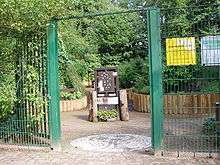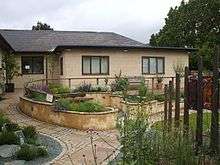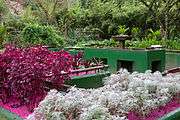Sensory garden

A sensory garden is a self-contained garden area that allows visitors to enjoy a wide variety of sensory experiences.[1] Sensory gardens are designed to provide opportunities to stimulate the senses, both individually and in combination, in ways that users may not usually encounter.[2]
Sensory gardens have a wide range of educational and recreational applications.[1] They can be used in the education of special-needs students, including people with autism.[3] As a form of horticultural therapy, they may be helpful in the care of people with dementia.[4]
Sensory gardens can be designed in such a way as to be accessible and enjoyable for both disabled and non-disabled users. A sensory garden, for example, may contain features accessible to the disabled individual such as: scented and edible plants, sculptures and sculpted handrails, water features designed to make sound and play over the hands, textured touch-pads, magnifying-glass screens, braille and audio induction loop descriptions. Depending on the user group, other provisions may integrate sound and music more centrally to combine the play needs of younger users with their sensory needs.
Many sensory gardens devote themselves to providing experience for multiple senses; those specialising in scent are sometimes called scented gardens, those specialising in music/sound are sound gardens where the equipment doubles up to provides an enhanced opportunity for strategic developmental, learning and educational outcomes.
Sensory Gardens usually have an enhanced infrastructure to permit wheelchair access and meet other accessibility concerns; the design and layout provides a stimulating journey through the senses, heightening awareness, and bringing positive learning experiences.
- Some sensory gardens
 This sensory garden is designed for children with special needs at St Christopher's School in Westbury Park, Bristol, England.
This sensory garden is designed for children with special needs at St Christopher's School in Westbury Park, Bristol, England. The Blindengarten in the Bad Homburg Spa Park (Kurpark) in Germany is a "smell and touch" garden comprising eight thematically-planted raised beds (culinary herbs, medicinal herbs, roses, grasses, etc) arranged around a central fountain that can provide acoustic orientation for blind and visually-impaired people.[5]
The Blindengarten in the Bad Homburg Spa Park (Kurpark) in Germany is a "smell and touch" garden comprising eight thematically-planted raised beds (culinary herbs, medicinal herbs, roses, grasses, etc) arranged around a central fountain that can provide acoustic orientation for blind and visually-impaired people.[5] An experiential feature in the "World of the Senses" (Welt der Sinne). The design of this extensive sensory garden and house in Bremervörde, Germany, was inspired by the ideas of Hugo Kükelhaus (1900–1984) regarding "fields of experience for the development of the senses" and is intended for use by everyone, regardless of disabilities.[6]
An experiential feature in the "World of the Senses" (Welt der Sinne). The design of this extensive sensory garden and house in Bremervörde, Germany, was inspired by the ideas of Hugo Kükelhaus (1900–1984) regarding "fields of experience for the development of the senses" and is intended for use by everyone, regardless of disabilities.[6] This sensory garden inside the Rio de Janeiro Botanical Garden, Brazil, is designed to sharpen the senses of touch and smell, and sometimes taste. Visitors with special needs, including the blind and visually impaired, are welcomed by a team of counselors (some of whom are themselves visually challenged). Blindfolded guided tours are also a feature.[7]
This sensory garden inside the Rio de Janeiro Botanical Garden, Brazil, is designed to sharpen the senses of touch and smell, and sometimes taste. Visitors with special needs, including the blind and visually impaired, are welcomed by a team of counselors (some of whom are themselves visually challenged). Blindfolded guided tours are also a feature.[7]
See also
References
- 1 2 "Sensory garden design advice 1. Sensory Trust". www.sensorytrust.org.uk. 21 February 2003. Retrieved 15 June 2018.
- ↑ "Sensory Gardens - Gardening Solutions - University of Florida, Institute of Food and Agricultural Sciences". gardeningsolutions.ifas.ufl.edu. Retrieved 2018-03-20.
- ↑ Hussein, H (December 2009). "Sensory Garden in Special Schools: The Issues, Design and Use". Journal of Design and Built Environment. 5 (1): 77–95. ISSN 2232-1500. Retrieved 15 June 2018.
- ↑ Gonzalez MT, Kirkevold M (October 2014). "Benefits of sensory garden and horticultural activities in dementia care: a modified scoping review". Journal of Clinical Nursing. 23 (19–20): 2698–715. doi:10.1111/jocn.12388. PMID 24128125. Retrieved 15 June 2018.
- ↑ "Kurpark". www.bad-homburg-tourismus.de. Bad Homburg Tourism. Retrieved 16 June 2018.
- ↑ Burfeind, Iris. "Hugo Kükelhaus". www.parkdersinne-brv.de (in German). Natur- und Erlebnispark Bremervörde GmbH. Retrieved 17 June 2018.
- ↑ "Jardim Sensorial de portas abertas — Jardim Botânico do Rio de Janeiro". jbrj.gov.br (in Portuguese). Governo do Brasil. Retrieved 17 June 2018.
